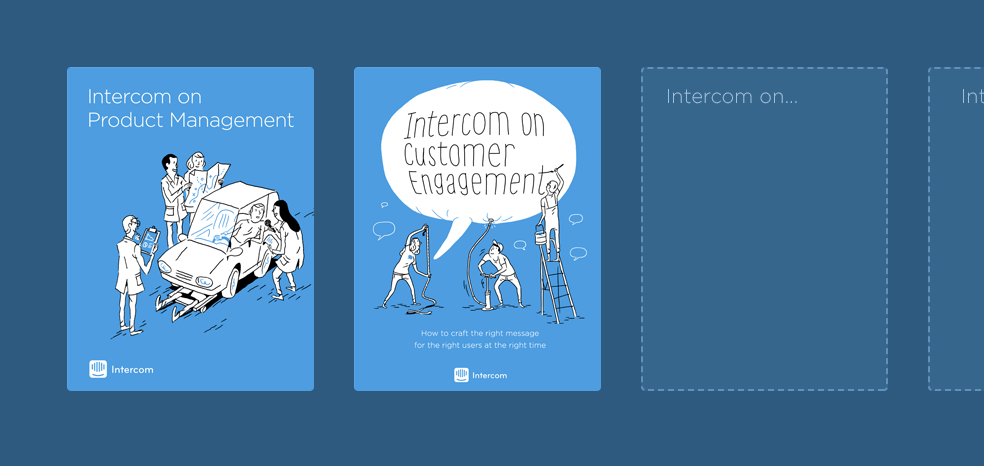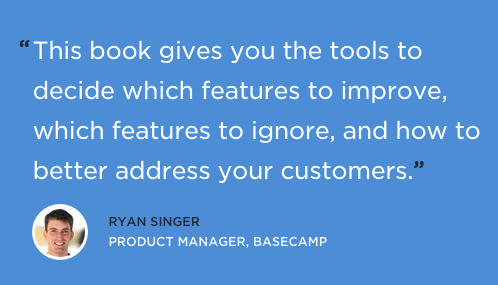Write books worth reading

They say everyone has at least one book in them. That might be true but the problem is getting it out and sharing it with the world.
At Intercom we’ve published two books now, Intercom on Product Management and Intercom on Customer Engagement, and in the process we’ve learned quite a bit.
Don’t get us wrong. We know business titles like this are easier to bring into the world than works of fiction where the author must invent, rationalize, and surprise all in one sitting. But if you want to produce a quality title that readers will get some genuine value out of, then there’s a certain amount of blood, sweat and maybe even tears you’ll have to invest in the project. The alternative is creating something half-assed that gathers digital dust – who doesn’t have at least a couple of downloaded books that they swear they are going to read any day now?
You’ve got limited time and money so it’s easy to see why cheap and nasty ways of making books start to look attractive. All you have to do is get some interns to round up industry best practice (i.e. re-write your competitors strongest blog posts), drop the text into a web-based book template, dream up a clickbait title, stick it behind an email signup form, and then sit back and watch new emails pour in. Good luck with that.
On the other hand you could produce a book that encapsulates what your company thinks about the world and the space you operate it, reflects your brand positively, and establishes your expertise in your space. If that’s your goal, here are some useful lessons we’ve learned trying to achieve it.
Write what you know
In a world of ebook overload, where even the very term ebook is devalued compared to “real” books, the ones that get read actually have something original and real to say.
To ensure you don’t go down the rabbit hole of forgettable content, write about what you know and write with conviction. If in doubt, think about your company mission and values – the best writing comes from your unwavering belief in how things should work. For instance, Intercom on Product Management speaks to our belief in launching small, understanding usage, gathering relevant feedback, and iterating fast. Intercom on Customer Engagement is all about why we think tailored, targeted customer communications is the future, and communicating like that will ensure your product and your business grow.
Estimate the time. Then double it.
One of the few certainties with large content projects is that they rarely get completed on time. Add to the mix that this is not your “day job” – you’ve still got your normal day to day duties to deal with – and it’s easy to see why deadlines can slip. Even if you hire an editor to work on the book they are going to need access to the people who are doing the job, which gives them the insights, which you want to share with your customers. Reality has a nasty way of getting in the way of projects like this.
That’s part of the reason why we never discussed in public that we were working on a book or even that a second one was in the works – the only deadline was our own. That’s not to say we didn’t have a project plan and strove to hit all the milestones along the way. But in both cases we ultimately made the call that it was better to miss our self-imposed deadline, than to publish something we weren’t fully happy with.
Don’t reinvent the book
There’s a reason books have survived for hundreds of years despite their death being predicted when each new medium – film, TV, the Internet – starts to explode in popularity. Books are extremely efficient and effective at what they do. So don’t feel you have to reinvent the format, just because you can. Producing something that looks, and reads, like an extended marketing brochure won’t satisfy anyone.
Just as software gets polished before it’s released into the wild, it’s important to pay attention to the smaller details that indicate you’ve created a serious publication. For example, get an ISBN number, a unique identifier for your book, that’s an industry standard. Not only do some retailers – both online and physical – demand it to stock and distribute your book but it sends a clear signal to your readers that this is a serious publication.
Nail down your production processes
Designing and producing a good looking readable book is more complex than you think. For our first book, Frantisek, the designer behind most of the images you see on this blog, was on a steep learning curve, which was probably not helped by the fact that we were all doing this for the first time.
The tools you use to create your book have a huge impact on how efficient this process is. First time around we created the book in Adobe InDesign which meant there was a single copy that only one person at a time could work on. For our second book we used an online publishing service, Woop.ie, which made collaboration and management of the process a lot simpler.
Proofreading is tedious and thankless work, but make it a priority to get as many people as possible to proofread a final draft of your book – ask colleagues, friends, family, even loyal customers to read a draft before you hit the publish button. Every typo you miss overshadows all those lovely, typo-free words around it. But more importantly make sure you have a process in place so that any suggested changes or fixes can be reported and implemented efficiently. You certainly don’t want people working across each other so make sure you have a single editor in control who is consistently applying your style guide.
Line up strong testimonials
No doubt you’ve got loyal readers of your blog or fans of your product who will download your book without a second thought. But others will need convincing and strong testimonials are a great way to do that. Before publication, send advance copies to influential leaders in your space and kindly ask for a quote to publish in your promotional material. Even if you don’t have pre-existing relationship most people will be flattered to be asked for their opinion and will be happy to oblige if the book is relevant to their area of expertise. It’s a time tested tactic of the dead tree publishing industry credible testimonials from respected industry veterans are powerful social proof for your book.
Another benefit of sending early copies to people you admire, is that you can solicit early feedback. Frankly, seeing a positive review from someone like Basecamp’s Ryan Singer settled any pre-release nerves we might have had about our first book. :)

Post-launch, we also added (with permission) positive tweets from people with clout. So big shout out and thanks to Ryan Singer, Hunter Walk, Dharmesh Shah, Josh Elman, David Cancel, Nir Eyal, Justin Jackson, John Koetsier, Mike Davidson, Bill Macaitis, Ann Handley, Brian Balfour, Brian Solis, and Samuel Hulick for helping us promote our books.
Interact with your readers
Publishing isn’t a one way medium these days. Books – like blogs – are a great opportunity for you to interact with your audience and get a better sense of what interests them. So make sure you author or authors have time to answer reader questions and generally engage your audience as much as possible on different sections of the book. Some of the things that have worked for us include podcast interviews, Product Hunt’s AMA (Ask Me Anything), exclusive demos with the authors, Quora discussions, interviews, etc. Each event created another opportunity for us to discuss the topics in the book and so pique people’s interest in it.
Treat it as a long term play
A book is the ultimate piece of evergreen content that can still be delivering benefits months after publication date. But you need to maximize the chances of that happening.
- chose topics that are likely to resonate in a year’s time – so the Ultimate Guide to Building Your First Apple Watch app is probably not a good topic.
- you should keep updating your book landing page with the latest and greatest tweets, endorsements, or any other relevant changes.
- write content that will still be true in a year
- follow that advice and you should still be seeing the benefits of your book publishing months later.
There are no shortcuts
Writing one proverbial bestseller isn’t easy, but it’s not uncommon. Writing two, three, or ten is hard. There aren’t any tricks here: focus on writing good content, present it tastefully, and engage with your readers afterwards. Ultimately, that’s what it takes for your content to inspire and resonate with people time and time again.







